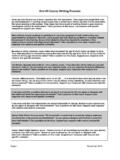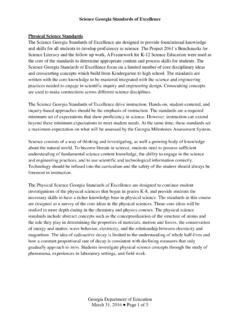Transcription of OMHEC standard for competence and skills of EOC
1 OMHEC standard for competence and skills for an EOC - Offshore Cranes North- Sea / Europe OMHEC sub committee for Enterprise of competence Document code Lapsed version dated Current version dated Drawn up by OMHEC EOC sub-com Approval by members countries OMHEC Approval board OMHEC North Sea Europe OMHEC T2st 07-01-2000 (3rd)t 02-04-03 22-05-2002 (2nd) 10-12-2001 (1st) 03-2003 02-04-2003 Identification code: OMHEC standard : competence and skills for an EOC of Offshore Cranes 04 2003 OMHEC standard competence and skills Requirements for an Enterprise of competence (EOC) of Offshore Cranes Relates to: Offshore cranes permanently mounted on offshore installations in the North Sea area, which are intended for deck work and for materials handling to and from supply vessels This document has been developed and issued by the Offshore Mechanical Handling Equipment Committee ( OMHEC ), Sub-committee for EOC of Offshore Cranes Members: Denmark, United Kingdom, Norway and the Netherlands Approved by OMHEC : April 2003 Agreed for issue by the following bodies: * The Offshore Industry of the involved countries operating in the North Sea area *The regulatory authorities of the involved countries operating in the North Sea area.
2 D - Danish Energy Authority UK - Health & Safety Executive N - Norwegian Petroleum Directorate NL - State Supervision of Mines OMHEC or its membership cannot be held responsible for any loss, damage or injury suffered by any person or organisation as a result of the interpretation and use of this document by any individual, third party or standard for competence and skills for an EOC - Offshore Cranes North- Sea / Europe OMHEC sub committee for Enterprise of competence CONTENTS 1 OMHEC SAFETY Expert OBJECTIVE WORKING GROUP EOC ..3 2 3 NORMATIVE 4 TERMS AND DEFINITIONS ..3 5 GENERAL 6 TASKS AND STRUCTURE OF AN EXPERT ORGANISATION OF Personnel Documentation of competence competence Responsible skills and 7 EXPERT VERIFICATION OF OFFSHORE OMHEC standard for competence and skills for an EOC - Offshore Cranes North- Sea / Europe OMHEC EOC standard sub committee page 1 of 15 Revision 0 1 INTRODUCTION OMHEC The Offshore Mechanical Handling Equipment Committee ( OMHEC ) comprises of members from the United Kingdom, Norway, Denmark, and the Netherlands, all of whom are involved with the safety of lifting equipment and lifting operations offshore.
3 Members represent regulatory authorities, industry organisations, independent verification bodies and classification societies. One of the major issues that committee members have been involved with over the last years has been to assess the implications of the UK Lifting Operations and Lifting Equipment regulations SI 2307 (LOLER) and to address the areas of concern which members had to the implementation of this document offshore. One such area that the committee wishes to express concern is with respect to the safety aspects of lifting equipment and lifting operations offshore. A relatively high number of incidents and accidents, including those resulting in the lost of life, give the background for focusing on the safety issues related to design, construction and operation of lifting appliances in the offshore environment. The potential dangers involved in the use of lifting equipment necessitate that the highest standards of safety are applied through the whole lifting process and operation.
4 The safety elements given in below reflect the committee s view on what constitutes elements of competence , which will ensure that the standards of safety are achieved. OMHEC objectives OMHEC s objectives are to contribute to improved safety in offshore lifting operations and to be the arena for work to harmonise good practices in lifting operations in the North Sea. In this respect the exchange of experience of accidents and incidents plays an important part in the committee s work. The committee has established two work groups, with representation from each of the participating countries, to develop documents that will constitute OMHEC s advice in specific areas related to lifting operations. OMHEC shall also be the arena for information exchange and discussions related to legislative policy, research and development, standardisation of guidance and procedures and other issues relating to offshore mechanical handling equipment.
5 This involves cranes, hoists, winches and goods lifts used on offshore installations and vessels. OMHEC has established two Working Groups, which will constitute OMHEC s advice on the question of training of personnel involved in lifting operations and competency of the EOC. Safety Elements Background It is recognised that the competent person or competent identity covers many areas in the field of design, manufacture, operation etc. and that it would be unrealistic for any one person to fulfil the necessary elements of competency for every role in the field of lifting and handling equipment and its operations. Some of the particular areas where the competent person will be involved will be tabled below although it should be noted that this list is by no means is exhaustive. Throughout this chapter the term EOC has been used frequently, the definition of this term is given in chapter 4 Definitions of this document.
6 OMHEC standard for competence and skills for an EOC - Offshore Cranes North- Sea / Europe OMHEC EOC standard sub committee page 2 of 15 Revision 0 Design The quality of the design of offshore cranes provides the basis for safe operations. It is essential that personnel responsible for the design and manufacture take into account the intended operational aspects of the offshore cranes and also the environment in which the offshore cranes are to be used. Organisations and personnel involved in this area must also have at their disposal the necessary knowledge of all the aspects involved in the good and safe design of offshore cranes. This should include static and dynamic design calculations as well as human engineering and, where applicable, ergonomic factors to be used in the design of the workstation for the operator of the equipment. The design should take into account the requirement for ease of maintenance, inspection and expert verification during the operation phase.
7 If part of the intended operation of the offshore crane is lifting personnel higher than three metres then the offshore crane shall be specially designed for this operational mode. In this case the offshore crane shall be regarded as a safety critical machine. In this instance a notified independent inspection body shall perform the design verification and fabrication survey. Technical requirements as given in prEN 13852-1 regarding lifting of personnel shall apply. Risk assessment should be used during design to avoid failures due to known failure modes and form the basis for risk-based maintenance and risk-based inspection. The failure mode analysis should also take into account factors that may be present during the unintended use of offshore cranes. Manufacturing Manufacturers of offshore cranes shall have in effect a quality assurance system according to a recognised standard , EN-ISO 9001, thus organisations that purchase and operate offshore cranes can be assured that necessary quality is achieved.
8 All functions should, as far as reasonably practicable, be tested and verified as being fit for purpose by the manufacturer/supplier at his premises before the offshore crane is shipped and mounted to its final destination. Operation All personnel involved with lifting operations shall have the necessary training skills and experience in such operations. The EOC or entity should regularly (during annual control) assess such skills utilising international recognised standards and codes of practice for safe use. The offshore crane itself shall always be operated within the limits specified by the manufacturer/supplier Maintenance Maintenance and inspection shall be carried out in accordance with a plan prepared on the background of information from the manufacturer, the use of the equipment, the environment at the worksite and a risk (RCM /RBM/RBI) analysis. Expert verification An EOC shall verify that the offshore crane has been installed, tested and examined satisfactory, and issue a certificate to this effect before it is put into operation.
9 Whenever the offshore crane has been modified, re-sited or subjected to a major repair, the EOC shall verify that the equipment is fit for use and in accordance with applicable regulations and applied standards . The owner of the offshore crane should by control of documentation issued by a recognised organisation or certifying or accreditation body that the EOC has sufficient competence (theoretical knowledge and practical experience) to understand the design, calculations and operation of offshore cranes and to carry out the necessary examinations and tests. OMHEC standard for competence and skills for an EOC - Offshore Cranes North- Sea / Europe OMHEC EOC standard sub committee page 3 of 15 Revision 0 Objective Working Group EOC OMHEC s aim is to standardise on the competency requirements for organisations / units and personnel an EOC, involved in expert verification of offshore cranes on fixed installations and mobile units in the North Sea sector.
10 2 SCOPE This OMHEC guideline outlines the competence of business organisations and personnel involved in expert verification of offshore cranes and the tasks involved in expert verification, and it is recommended as an industry standard to be used for such activities within the participating countries; Denmark, Holland, Norway and UK. 3 NORMATIVE REFERENCES The following references include provisions, which, through reference in this text, constitute provisions of this OMHEC standard . Latest issue of the references shall be used unless otherwise agreed. Other recognised standards may be used provided it can be shown that they meet or exceed the requirements of the regulations and standards referenced below. EN-45004 General criteria for the operation of various types of bodies performing inspection PrEN 13852-1 Cranes-Offshore cranes. Part1: General purpose offshore cranes ISO Inspection and testing of cranes.















